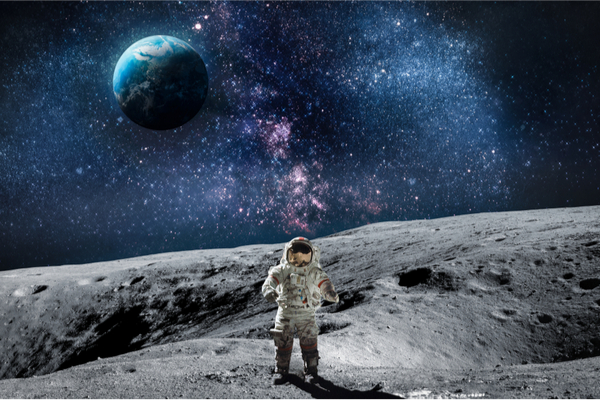The moon is shrinking, and hours-long “moonquakes” and landslides could make the lunar south pole a risky place for astronauts to touch down in the future.
As CNN reports, multiple missions are targeting the region with the aim of potentially using its ice deposits for a sustained human presence on the moon. As the moon’s core gradually cools and shrinks, its surface develops creases — like a grape shriveling into a raisin — that create “moonquakes” that can last for hours, as well as landslides, according to a new study funded by NASA.
Interest in the lunar south pole spiked last year, when India’s Chandrayaan-3 mission made the first successful soft landing in the area, just days after Russia’s Luna-25 spacecraft crashed en route to attempt the same feat. NASA has selected the region as the landing site for its Artemis III mission, which could mark the return of astronauts to the moon as soon as 2026, and China also has plans to create future habitats there.
Seismometers placed by Apollo astronauts decades ago recorded a lunar quake that reached the equivalent of a magnitude 5.0 magnitude quake on Earth. That may seem moderate, but the moon’s lower gravity could make it feel worse. “On the Earth, you have a much stronger gravity keeping you attached to the surface. On the moon, it’s much smaller, so even a little bit of ground acceleration is going to potentially pop you off your feet, if you’re walking along. That kind of shaking can really start throwing things around in a low G environment,” said Thomas R. Watters, a senior scientist emeritus in the National Air and Space Museum’s Center for Earth and Planetary Studies.
Much like the rest of the natural satellite’s surface, the area of the south pole that is the subject of so much interest is prone to these seismic phenomena, potentially posing a threat to future human settlers and equipment. “This is not to alarm anyone and certainly not to discourage exploration of that part of the south pole of the moon,” said the study’s lead author, Thomas R. Watters, a senior scientist emeritus in the National Air and Space Museum’s Center for Earth and Planetary Studies, “but to raise the caution that the moon is not this benign place where nothing is happening.”
The findings of the study will not affect the Artemis III landing region selection process, and that’s due to the scope and duration of the mission, according to study coauthor and NASA planetary scientist Renee Weber. “This is because estimating how often a specific region experiences a moonquake is difficult to do accurately, and like earthquakes, we can’t predict moonquakes,” Weber said. “Strong shallow moonquakes are infrequent and pose a low risk to short-term missions on the lunar surface.”
NASA has identified 13 Artemis III candidate landing regions near the lunar south pole, she added, using criteria such as the ability to land safely in the region, the potential to meet science objectives, launch window availability and conditions such as terrain, communications and lighting. As part of the mission, two astronauts will spend about a week living and working on the lunar surface.
However, Weber said, for a long-term human presence on the moon, the site selection process could indeed factor in geographic characteristics such as proximity to tectonic features and terrain.
Moonquakes could indeed be a problem for future manned landing missions, said Yosio Nakamura, a professor emeritus of geophysics at the University of Texas at Austin, who was among the researchers who first looked at the data collected by the Apollo seismic stations.
However, Nakamura, who was not involved with the study, disagrees about the cause of the quakes, and said Apollo data shows the phenomena originate tens of kilometers below the surface. “We still don’t know what causes shallow moonquakes, but it is not the sliding fault near the surface,” he said. “Regardless of what causes those quakes, it is true that they pose a potential threat to future landing missions, and we need more data about them.”
Regardless of the underlying cause, the potential danger moonquakes pose to astronauts will be limited by the fact that — at least in the near future — humans will be on the moon for short periods of time, a few days at most, according to Allen Husker, a research professor of geophysics at the California Institute of Technology who was also not involved with the study.
“It is very unlikely that a large moonquake will happen while they are there. However, it is good to know that these seismic sources (causing the quakes) exist. They can be an opportunity to better study the moon as we do on the Earth with earthquakes,” Husker said. “By the time there is an actual moon base, we should have a much better idea of the actual seismic hazard with upcoming missions.”
That sentiment is shared by Jeffrey Andrews-Hanna, an associate professor of planetary science at the University of Arizona, who also didn’t participate in the work. “Moonquakes are an incredible tool for doing science,” he said in an email. “They are like flashlights in the lunar interior that illuminate its structure for us to see. Studying moonquakes at the south pole will tell us more about the Moon’s interior structure as well as its present-day activity.”
—
Photo Credit: Dima Zel / Shutterstock.com
